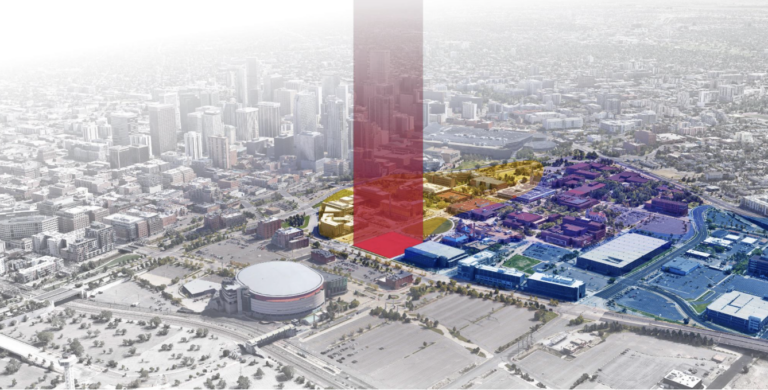Auraria Higher Education Center (AHEC) and developer Columbia Ventures are set to develop two buildings on the Auraria Campus – one for commercial use and the other for residential purposes – on a two-acre vacant parcel of land at the intersection of 11th St. and Auraria Parkway. The commercial building will include space dedicated to workforce development, higher education and retail/commercial office space. The residential building will include mixed-income housing and an early childhood learning center.
“The advantages of a mixed-use development, like Ballfield at Auraria, for our campus and the downtown Denver community are unparalleled,” said Colleen Walker, CEO of Auraria Higher Education Center. “Together, with the mission-aligned organizations investing in this project, we’ll create new spaces for accessible housing opportunities, early and higher educational programs and continue to support workforce development. Ultimately, this development will shift our campus from being a place where people gather during the school week, to a vibrant, thriving community all week-long. We are excited to see the impacts of this project on our campus, for our students and surrounding communities.”
The project name, Ballfield at Auraria, is a nod to the previous site of Metropolitan State University of Denver’s (MSU Denver) baseball field. In 2015, the field moved to its current location at the Assembly Athletic Complex (1600 W. Colfax Ave.). The development may include the following components, among others that are to be determined:
Commercial
- MSU Denver will collaborate with CCD to relocate the Classroom to Career Hub (C2), a program that dramatically scales student and industry connections to support Colorado’s workforce and economy, from disparate locations across the campus to the new building. This will create a central location for prospective employers and industry partners to convene and collaboratively plan to solve our state’s pressing workforce issues, build synergy with faculty, and recruit students to meet their talent needs.
- AHEC will consolidate their administrative offices which are currently scattered throughout campus, within the office building. The move will accommodate AHEC’s strategic masterplan by opening space on campus for its institutional partners.
Residential
- The Auraria Early Learning Center, with programs for children 12-months to 5-years old, will move from its current location at 950 9th St. to the new building, which will provide a larger space for the school so it can expand services to reduce its current waitlist and the increasing demand for childcare.
- More than 300 units of mixed-income housing for households with an anticipated range of 60% to 120% of area median income (AMI).
- A portion of these units will be available to eligible faculty and staff from all three institutions to help attract and retain top talent.
“This Ballfield at Auraria project offers an adept opportunity for us to be an economic catalyst for our community and contribute to the sustainability of our campus, both key pillars of our strategic plan,” said Janine Davidson, Ph.D. president of Metropolitan State University of Denver. “Not only are we aiming to support MSU Denver employees by providing access to affordable housing, but we hope to be a leader in the reinvention of community in downtown Denver. We look forward to sharing more detail on the project soon.”
Within the two new buildings there will be additional opportunities for commercial mixed-use and retail space to bring more amenities to campus. Special consideration will be offered to alumni-led, mixed-use, and retail tenants as well as to tenants who provide workforce-training opportunities for students and alumni.
Except for the Auraria Early Learning Center, the residential building is anticipated to be owned and financed by Columbia Ventures. Both the commercial building and the learning center will be condominiumized, with each owner identifying the optimal capital stack to meet their respective needs. It is anticipated these stacks will include cash, local, state, and federal grants, capital campaigns, PRI and debt that does not involve student fees.









